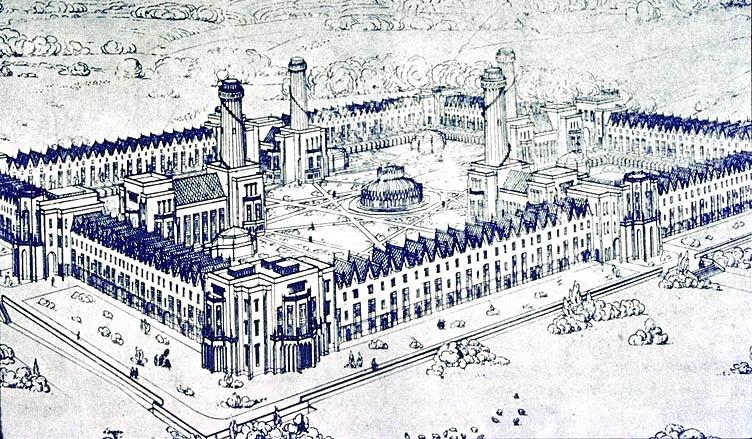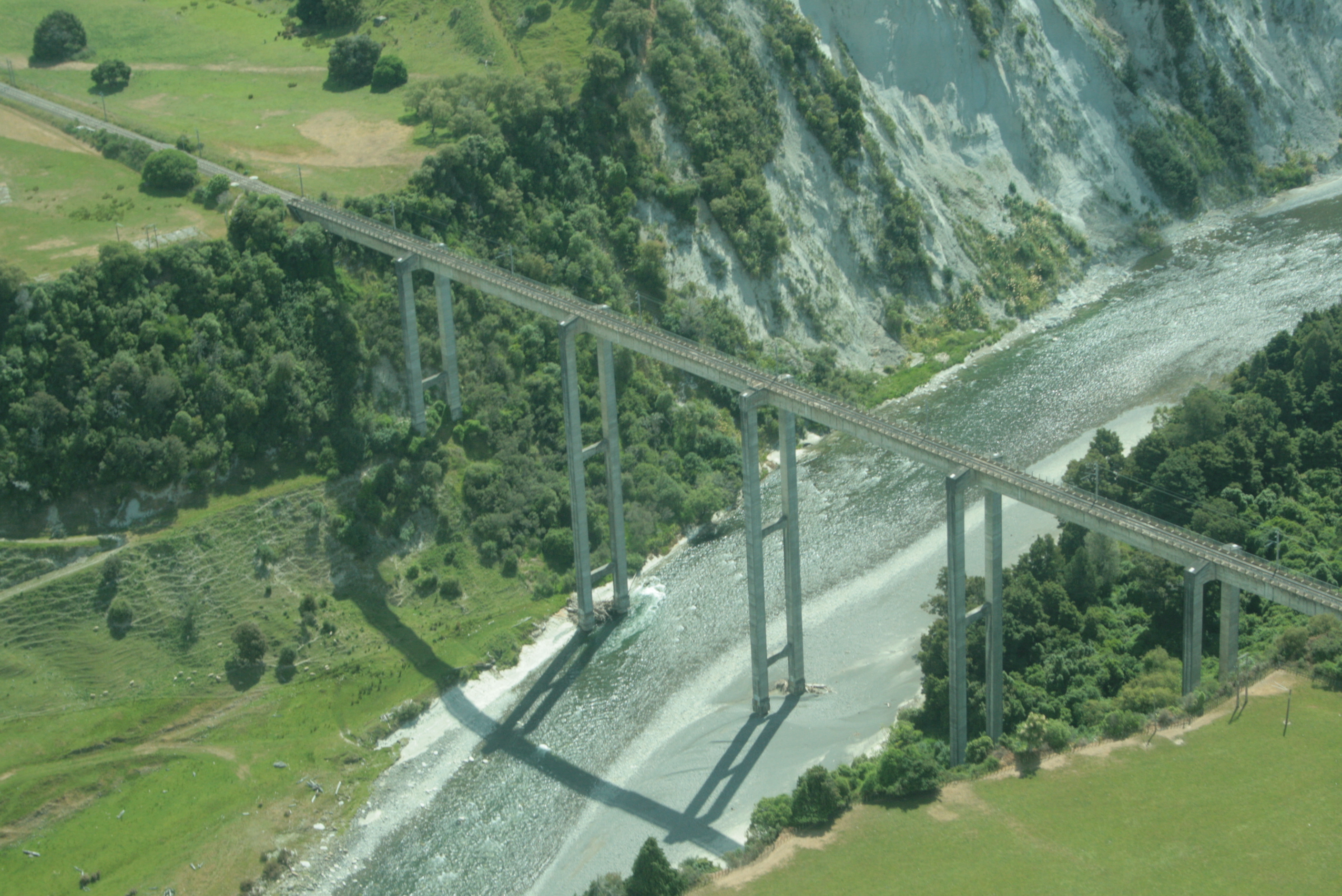|
Mangaonoho Railway Station
Mangaonoho railway station was a station on the North Island Main Trunk in New Zealand. For almost a decade, from 1893 to 1902, Mangaonoho was important as the northern terminus of the NIMT's southern section; even a refreshment room was planned. The route north was delayed by construction of major viaducts, the first being Makōhine. To build Makōhine a railway workshop was set up just north of Mangaonoho. Unlike many other NIMT construction camps, Mangaonoho gradually declined after the line was completed. By 1911 the population was down to 167. Decline continued, with removal of the stockyards in 1973 and closure in 1982. There is now only a single line through the former station site. The New Zealand Ministry for Culture and Heritage gives a translation of "the stream of Noho" for ''Mangaonoho''. History A platelayer's cottage and siding were built in 1892, and a sawmill was moved to the station in 1893. The extension from Kaikarangi (or Rangatira as it then was) was c ... [...More Info...] [...Related Items...] OR: [Wikipedia] [Google] [Baidu] |
North Island Main Trunk
The North Island Main Trunk (NIMT) is the main railway line in the North Island of New Zealand, connecting the capital city Wellington with the country's largest city, Auckland. The line is long, built to the New Zealand rail gauge of and serves the large cities of Palmerston North and Hamilton. Most of the NIMT is single track with frequent passing loops, but has double track - * between Wellington and Waikanae, except for of single-track through tunnels between North Junction ( from Wellington) and South Junction, ( from Wellington), on the Pukerua Bay to Paekakariki section, * between Hamilton and Te Kauwhata (except for the single-track Waikato River Bridge at Ngāruawāhia), and * between Meremere and Auckland Britomart. Around (approximately 65%) of the line is electrified in three separate sections: one section at 1600 V DC between Wellington and Waikanae, and two sections at 25 kV AC: between Palmerston North and Te Rapa (Hamilton) and between Papakura and ... [...More Info...] [...Related Items...] OR: [Wikipedia] [Google] [Baidu] |
Marton Railway Station, Manawatu-Wanganui
Marton may refer to: Places England * Marton, Blackpool, district of Blackpool, Lancashire * Marton, Bridlington, area of Bridlington in the East Riding of Yorkshire * Marton, Cheshire, village and civil parish in Cheshire * Marton, Cumbria, village in Cumbria * Marton, East Riding of Yorkshire, hamlet in the East Riding of Yorkshire * Marton, Harrogate, village in North Yorkshire * Marton, Lincolnshire, village in Lincolnshire * Marton, Middlesbrough, suburb of Middlesbrough * Marton, Myddle, Broughton and Harmer Hill, a location in Shropshire * Marton, Ryedale, village in North Yorkshire * Marton, Shropshire or Marton-in-Chirbury, village in Shropshire * Marton, Warwickshire, village in Warwickshire * Marton-in-the-Forest, North Yorkshire * Marton-le-Moor, village in North Yorkshire * Long Marton, parish of Eden, Cumbria * Whitegate and Marton, parish of Vale Royal, Cheshire Elsewhere * Marton, New Zealand, town in the Manawatu-Wanganui region * Marton, Queensland, town ... [...More Info...] [...Related Items...] OR: [Wikipedia] [Google] [Baidu] |
Trestle Bridge
A trestle bridge is a bridge composed of a number of short spans supported by closely spaced frames. A trestle (sometimes tressel) is a rigid frame used as a support, historically a tripod used to support a stool or a pair of isosceles triangles joined at their apices by a plank or beam such as the support structure for a trestle table. Each supporting frame is a bent. A trestle differs from a viaduct in that viaducts have towers that support much longer spans and typically have a higher elevation. Timber and iron trestles (i.e. bridges) were extensively used in the 19th century, the former making up from 1 to 3 percent of the total length of the average railroad. In the 21st century, steel and sometimes concrete trestles are commonly used to bridge particularly deep valleys, while timber trestles remain common in certain areas. Many timber trestles were built in the 19th and early 20th centuries with the expectation that they would be temporary. Timber trestles were use ... [...More Info...] [...Related Items...] OR: [Wikipedia] [Google] [Baidu] |
Overlander (train)
The Overlander was a long-distance rail passenger train between Auckland and Wellington in the North Island of New Zealand, along the North Island Main Trunk (NIMT). It was operated by Tranz Scenic. The service was replaced from 25 June 2012, by the ''Northern Explorer''. The Overlander replaced a previous service operated by RM class ''Silver Fern'' railcars on Monday 2 December 1991. Following the withdrawal of the overnight '' Northerner'', it was the only regular passenger train on the NIMT between Pukekohe and Palmerston North. After being threatened with cessation itself in 2006, it gained significantly in popularity, partly because of increased tourism promotion for the service. It was called one of the best-value scenic rail trips in the world by the British ''Guardian''. It is also acknowledged as one of the world's classic scenic rail journeys. Route History Origins The first regular daylight Wellington-Auckland passenger train services, augmenting the older ove ... [...More Info...] [...Related Items...] OR: [Wikipedia] [Google] [Baidu] |
Daylighting (tunnels)
Daylighting a tunnel is to remove its "roof" of overlying rock and soil, exposing the railway or roadway to daylight and converting it to a railway or roadway cut. Tunnels are often daylighted to improve vertical or horizontal clearances—for example, to accommodate double-stack container trains or electrifying rail lines, where increasing the size of the tunnel bore is impractical. List of daylighted tunnels * New Zealand ** The railway line through the Manawatu Gorge, when constructed in 1891, had five tunnels. Three of these were daylighted in 2008 to allow for the carriage of large containers (the other two tunnels had their floors lowered). * United Kingdom ** Liverpool Lime Street station was originally approached through a twin-track tunnel completed in 1836. The tunnel was daylighted in the 1880s, and replaced with a deep four-track cutting, with only the eastern approaching Edge Hill railway station remaining as a tunnel. * United States of America ** Auburn Tunnel ... [...More Info...] [...Related Items...] OR: [Wikipedia] [Google] [Baidu] |
Worker Cooperative
A worker cooperative is a cooperative owned and Workers' self-management, self-managed by its workers. This control may mean a firm where every worker-owner participates in decision-making in a democratic fashion, or it may refer to one in which management is elected by every worker-owner who each have one vote. History Worker cooperatives rose to prominence during the Industrial Revolution as part of the labour movement. As employment moved to industrial areas and job sectors declined, workers began organizing and controlling businesses for themselves. Worker cooperatives were originally sparked by "critical reaction to industrial capitalism and the excesses of the industrial revolution." Some worker cooperatives were designed to "cope with the evils of unbridled capitalism and the insecurities of wage labor". The philosophy that underpinned the cooperative movement stemmed from the socialism, socialist writings of thinkers including Robert Owen and Charles Fourier. Robert Owen ... [...More Info...] [...Related Items...] OR: [Wikipedia] [Google] [Baidu] |
Horopito Railway Station
Horopito was a station on the North Island Main Trunk line, in the Ruapehu District of New Zealand. It served the small village of Horopito and lies just to the north of two of the five largest NIMT viaducts. It and Pokaka also lay to the south of Makatote Viaduct, the late completion of which held up opening of the station. A passing loop remains at the station site. History Surveying for the route between Hīhītahi and Piriaka began in 1894. The line opened from Waiouru to Rangataua for goods traffic on 12 August 1907 and a mail coach ran between the railheads at Raurimu and Rangataua, serving Horopito on the way. A stationmaster was appointed by March 1908. A telephone line from the north was in place by 1907, but a link to Mataroa was not installed until 1909. In August 1908 Horopito was the point where engines were changed on the first through train, to reduce its weight to negotiate the still unballasted track to the north. Work on the station building began i ... [...More Info...] [...Related Items...] OR: [Wikipedia] [Google] [Baidu] |
Mangaweka Deviation
The Mangaweka Deviation is a 7 km single track deviation of the North Island Main Trunk (NIMT) railway line in the central North Island of New Zealand, between the settlements of Mangaweka and Utiku, south of Taihape. Opened on 18 November 1981, by the Prime Minister, Robert Muldoon, it was constructed between 1973 and 1981 at a cost of $17m; to move the line away from geologically unstable land; and also to replace the high-maintenance steel viaducts including the Mangaweka Viaduct. It is the most recent and most significant deviation of the NIMT since it was opened in 1909. History The original section of the line was constructed as part of the NIMT in 1904. The entirety of the route from Marton north to Taihape was built to the west of the Rangitikei River and lies predominantly on the terraces within the river valley. Only south of Marton does the NIMT cross the Rangitikei en route to Palmerston North and Wellington. Between the settlements of Mangaweka and Utiku ... [...More Info...] [...Related Items...] OR: [Wikipedia] [Google] [Baidu] |
Whangamōmona
Whangamōmona is a small township in the Stratford District and Manawatū-Whanganui Region in New Zealand. It lies on State Highway 43, the "Forgotten World Highway", north-east of Stratford and south-west of Ohura. By rail it is from Stratford on the Stratford-Okahukura railway line.Wises New Zealand Guide, 7th Edition, 1979. p. 506. History The first European settlers arrived in 1895, with the town proper established some 2 years later. Growth of the town was seriously affected by the loss of 51 men (including the smaller nearby settlements of Kohuratahi and Tahora) in the First World War and a major flood in 1924. The town recovered with arrival of the railway line in 1933 and electrification in 1959. However the town went into decline again and the school closed in 1979, followed nine years later by the post office. In July 2020, the name of the locality was officially gazetted as Whangamōmona by the New Zealand Geographic Board. Demographics The Whangamomona stat ... [...More Info...] [...Related Items...] OR: [Wikipedia] [Google] [Baidu] |
Stratford–Okahukura Line
The Stratford–Okahukura Line (SOL) is a secondary railway line in the North Island of New Zealand, between the Marton - New Plymouth Line (MNPL) and the North Island Main Trunk (NIMT) Railway, with 15 intermediate stations. It is long through difficult country, with 24 tunnels, 91 bridges and a number of sections of 1 in 50 (2 %) grade. Near Okahukura there is an unusual combined road-rail bridge over the Ongarue River, with the one-lane road carriageway below the single rail track. The line is not currently in service for rail traffic and is under a 30-year lease for a tourist venture. In July 2019 KiwiRail's CEO stated that reopening the line was a priority. Minister of Transport Michael Wood announced the government's 10-year plan for rail investment on 6 May 2021, which specifically stated that plans could include re-opening the Stratford to Okahukura line. Construction Original construction The line from Stratford to Whangamōmona (of about ) was authorised by t ... [...More Info...] [...Related Items...] OR: [Wikipedia] [Google] [Baidu] |






